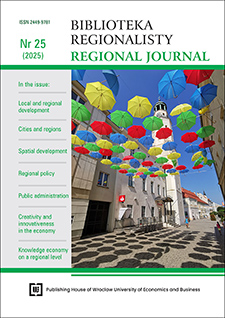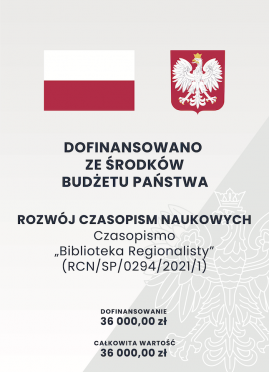Metropolitan delimitation in spatial perspective: selected Asian and European case studies
DOI:
https://doi.org/10.15611/br.2025.1.09Keywords:
metropolis, metropolitan delimitationAbstract
Aim: The study aims to analyse and compare the various approaches to defining and delimiting metropolitan areas, with a specific focus on cases from the European Union and selected Asian countries (China and Japan).
Methodology: The study applies a qualitative comparative analysis based on a comprehensive review of legal documents, statistical frameworks, and academic literature, supported by illustrative case studies from the European Union, China, and Japan.
Results: The research identified key delimitation criteria, including administrative boundaries, commuting patterns, population thresholds, urban density, socio-economic interactions, urban sprawl, governance models, and levels of economic integration. It revealed that the European Union tends to apply more standardised frameworks, whereas Asian countries favour more flexible, context-specific practices.
Implications and recommendations: The findings emphasise the complexity of achieving consistency in metropolitan delimitation, especially for cross-national comparisons and policy design. The study recommends adopting flexible and context-sensitive delimitation methods that reconcile governance needs with functional urban realities.
Originality/value: The study contributes to the ongoing debate on metropolitan governance by highlighting how differences in delimitation approaches influence urban planning and socio-economic cohesion. It offers a nuanced perspective on the tensions between standardisation and contextual adaptation in urban policy frameworks.
Downloads
References
Adobati, F., & Debernardi, A. (2022). The Breath of the Metropolis: Smart Working and New Urban Geographies. Sustainability, 14(2), 1028. https://doi.org/10.3390/su14021028
Aoki, T. (2022). Confronting Future Urban Perforation: Spatial Analysis of Districts in Japan with Potential for Being Sparsely Inhabited. Cities, 122, 103515. https://doi.org/10.1016/j.cities.2021.103515
Arban, E. (2018). Redrawing the Boundaries of City Governance: Metropolitan Cities, Federalism and Socio-Economic Challenges. SSRN Electronic Journal. https://doi.org/10.2139/ssrn.3315781
Buhnik, S. (2011). From Shrinking Cities to Toshi no Shukushō: Identifying Patterns of Urban Shrinkage in the Osaka Metropolitan Area. Berkeley Planning Journal, 23(1), 132-155. https://doi.org/10.5070/bp323111434
Cang, Z., Chen, T., Huang, X., & Zhou, Y. (2024). Redefining the Boundaries of Chinese Bities Analysis Based on Administrative Boundary Changes and Urban Functionality. Cities, 149(102), 104984.
Carnegie Endowment for International Peace. (2018). Flexibility is Not Europe’s Miracle Solution. Retrieved from https://carnegieendowment.org/research/2018/06/flexibility-is-not-europes-miracle-solution
Census.gov. (2023, July 25). About. United States Census Bureau. https://www.census.gov/programs-surveys/metro-micro/about.html
Central Statistical Office of Poland (GUS). (2024). Metropolitan Areas in Poland. Retrieved from https://stat.gov.pl
Chatterjee, A., & Chattopadhyay, R. N. (2020). Growth of Metropolises and Megacities with Focus on the Global South. In B. Dahiya (Ed.), Advances in 21st Century Human Settlements (pp. 1-28). Springer Singapore. https://doi.org/10.1007/978-981-15-1502-6_1
Christiawan, P. I., & Nguyen, T. P. L. (2024). Peri-Urbanization in Populous Developing Asian Countries: A Systematic Review. International Journal of Sustainable Development & Planning, 19(3), 949-962. https://doi.org/10.18280/ijsdp.190313
Constitution of India. (1992). The 74th Amendment. Retrieved from https://legislative.gov.in/constitution-of-india
Cui, L., & Shi, J. (2012). Urbanization and Its Environmental Effects in Shanghai, China. Urban Climate, 2, 1-15. https://doi.org/10.1016/j.uclim.2012.10.008
da Cruz, N. F., Oh, D. Y., & Choumar, N. B. (2020). The Metropolitan Scale. Cities, 100, 102644. https://doi.org/10.1016/j.cities.2020.102644
Department of Statistics Malaysia. (2024). Urban Agglomerations and Metropolitan Areas. Retrieved from https://www.dosm.gov.my
Dijkstra, L., & Poelman, H. (2014). A Harmonised Definition of Cities and Rural Areas: The New Degree of Urbanisation. Regional Working Paper, DG REGIO, European Commission.
Dijkstra, L., Poelman, H., & Veneri, P. (2019). The EU-OECD Definition of a Functional Urban Area. OECD Regional Development Working Papers, 11. https://doi.org/10.1787/d58cb34d-en
Duché, G. (2010). Metropolizacja, niezrównoważony wzrost a model globalnej akumulacji. Korzyści i koszty. Acta Universitatis Lodziensis. Folia Oeconomica, 245, 5-19.
ESPON. (2020). Functional Urban Areas and Their Relevance in Policy. ESPON Policy Brief. Retrieved from https://www.espon.eu
European Commission. (2021). Applying the Degree of Urbanisation: A Methodological Manual to Define Cities, Towns, and Rural Areas for International Comparisons (2021 edition). Publications Office of the European Union. https://ec.europa.eu/eurostat/documents/3859598/15348338/KS-02-20-499-EN-N.pdf/0d412b58-046f-750b-0f48-7134f1a3a4c2?t=1669111363941
European Union. (2012). The Governance of Metropolitan Regions. Forum of Federations / ESPAS / European Commission. Retrieved June 13, 2025, from https://espas.secure.europarl.europa.eu/orbis/system/files/generated/document/en/Consolidated%2520version%2520-%2520Metropolitan%2520Governance%2520-%2520final.pdf?utm_
Eurostat. (2024). Functional Urban Areas and Metropolitan Regions. Retrieved from https://ec.europa.eu/eurostat
Federal Institute for Research on Building, Urban Affairs and Spatial Development (BBSR). (2024). Metropolitan Regions in Germany. Retrieved from https://www.bbsr.bund.de
Giuliano, G., Kang, S., & Yuan, Q. (2019). Agglomeration Economies and Evolving Urban Form. The Annals of Regional Science, 63(3), 377-398. https://doi.org/10.1007/s00168-019-00957-4
Gonçalves, J., Pinto, P., & Santos, M. (2022). Who and How Decides When and Where? Drifts and Deadlocks in Metropolitan Governance. Urban Research & Practice, 16(3), 374-393. https://doi.org/10.1080/17535069.2022.2033308
Google Maps. (n.d.). Retrieved January 20, 2025, from https://www.google.com/maps
Graizbord, B., Perez, T., & Enrique, D. (2012). Megacities, Metropolitan Areas, and Local Governments. CEDUA-COLMEX. https://biblioteca-repositorio.clacso.edu.ar/handle/CLACSO/8645
Gu, X., Xie, B., Zhang, Z., & Guo, H. (2019). Rural Multifunction in Shanghai Suburbs: Evaluation and Spatial Characteristics Based on Villages. Habitat International, 92, 102041. https://doi.org/10.1016/j.habitatint.2019.102041
Hajrasouliha, A. H., & Hamidi, S. (2016). The Typology of the American Metropolis: Monocentricity, Polycentricity, or Generalized Dispersion? Urban Geography, 38(3), 420-444. https://doi.org/10.1080/02723638.2016.1165386
Heblich, S., Redding, S., & Sturm, D. (2018). The Making of the Modern Metropolis: Evidence from London. National Bureau of Economic Research. https://doi.org/10.3386/w25047
INSEE. (2024). Aires Métropolitaines and Grandes Aires. Retrieved from https://www.insee.fr
iReloChina (n.d.). https://www.irelochina.com/en/guide.html
Italian National Institute of Statistics (ISTAT). (2024). Città Metropolitane. Retrieved from https://www.istat.it
Jałowiecki, B. (2007). Globalny świat metropolii. Scholar Scientific Publishing House.
Jasiński, A. (2010). Proces metropolizacji i istota rozwoju współczesnych metropolii. Społeczeństwo i Edukacja Międzynarodowe Studia Humanistyczne, 2, 225-234.
Korenik, S. (2011). Region ekonomiczny w nowych realiach społeczno-gospodarczych. CeDeWu.
Li, B., Zhang, W., Shu, X., Pei, E., Yuan, X., Sun, Y., Wang, T., & Wang, Z. (2016). The Impacts of Urbanization on the Distribution and Body Condition of the Rice-Paddy Frog (Fejervarya multistriata) and Gold-Striped Pond Frog (Pelophylax plancyi) in Shanghai, China. Asian Herpetological Research, 7(3), 200-209. https://doi.org/10.16373/j.cnki.ahr.150061
Mikuła, Ł. (2010). Metropolia a region – problemy ustrojowe i polityczne. Acta Universitatis Lodziensis, 245, 49.
Mumford, L. (1963). The City in History. Its Origins, Its Transformations, and Its Prospect.
Mydel, R. (2021). Proces metropolizacji megamiasta Tokio. Kucharski Publishing House.
National Bureau of Statistics of China. (2024). Administrative Divisions and Metropolitan Areas. Retrieved from http://www.stats.gov.cn
National Institute of Statistics (INE). (2024). Urban and Metropolitan Areas in Spain. Retrieved from https://www.ine.es
Office for National Statistics. (2024). Metropolitan Counties in England. Retrieved from https://www.ons.gov.uk
Office of the National Economic and Social Development Council (NESDC), Thailand. (2024). Bangkok Metropolitan Region. Retrieved from https://www.nesdc.go.th
Okraszewska, R., Jamroz, K., Michalski, L., Żukowska, J., Grzelec, K., & Birr, K. (2019). Analysing Ways to Achieve a New Urban Agenda-Based Sustainable Metropolitan Transport. Sustainability, 11(3), 813. https://doi.org/10.3390/su11030813
Orellana, A., & Fuentes, L. (2019). Metropolitan Area. In A. M. Orum (Ed.), The Wiley-Blackwell Encyclopedia of Urban and Regional Studies. https://doi.org/10.1002/9781118568446.eurs0198
Orum, A. (2014). The Metropolis. In Concise Encyclopedia of Comparative Sociology (pp. 174-181). BRILL. https://doi.org/10.1163/9789004266179_018
Perez, J., Araldi, A., Fusco, G., & Fuse, T. (2019). The Character of Urban Japan: Overview of Osaka-Kobe’s Cityscapes. Urban Science, 3(4), 105. https://doi.org/10.3390/urbansci3040105
Philippine Statistics Authority. (2024). Metropolitan Regions in the Philippines. Retrieved from https://psa.gov.ph
Prusek, A. (2011). Metropolizacja w Polsce – szansa czy utopia? Gospodarka przestrzenna XXI wieku – nowe wyzwania. Prace Naukowe Uniwersytetu Ekonomicznego we Wrocławiu, (152), 416-428.
Radło, M.-J., & Szczech-Pietkiewicz, E. (2022). Role of Metropolis in Regional and Global Dimension of Value-Added Chain: Examples from Warsaw and Its Region. Sustainability, 14(21), Article 13937.
Skrzypek, E. (2017). Sieciowość jako cecha nowej gospodarki. Studia Informatica Pomerania, 2(44), 21-31.
Statbel. (2024). Commuting Zones and Metropolitan Areas in Belgium. Retrieved from https://statbel.fgov.be
Statistics Bureau of Japan. (n.d.). Major Metropolitan Areas. Retrieved from https://www.stat.go.jp/english/data/jyutaku/15025.html
Statistics Finland. (2024). Functional Urban Areas in Finland. Retrieved from https://www.stat.fi
Statistics Korea. (2024). Administrative Divisions and Metropolitan Cities. Retrieved from https://www.kostat.go.kr
Statistics Netherlands (CBS). (2024). Randstad Region. Retrieved from https://www.cbs.nl
Statistics Poland. (n.d.). Metropolitan Typology. In Regional Statistics – Classification of Territorial Units – Union Territorial Typologies (TERCET). Retrieved June 13, 2025, from https://stat.gov.pl/en/regional-statistics/classification-of-territorial-units/union-territorial-typologies-tercet/metropolitan-typology/?pdf=1
Statistics Sweden. (2024). Metropolitan Regions in Sweden. Retrieved from https://www.scb.se
Szymańska, D. (2008). Urbanizacja na świecie. PWN.
Tokyo Metropolitan Government. (n.d.). Japan’s Local Government System. Retrieved from https://www.metro.tokyo.lg.jp/ENGLISH/ABOUT/STRUCTURE/structure01.htm
Wang, H., Shi, Y., Zhang, A., Cao, Y., & Liu, H. (2017). Does Suburbanization Cause Ecological Deterioration? An Empirical Analysis of Shanghai, China. Sustainability, 9(1), 124. https://doi.org/10.3390/su9010124
World Bank. (2017). East Asia and Pacific Cities – Expanding Opportunities for the Urban Poor (East Asia and Pacific
Urbanization Review). DC: World Bank Group. Retrieved June 13, 2025 from https://openknowledge.worldbank.org/server/api/core/bitstreams/5ec7c925-2200-57d9-9b1b-6f5cb06f3e60/content
World Bank Group. (2017). Case Study on Tokyo Metropolitan Region, Japan: Policy Paper Series 3. Tokyo Development Learning Center, World Bank Group. Retrieved from https://documents1.worldbank.org/curated/en/183801560943706394/pdf/Case-Study-on-Tokyo-Metropolitan-Region-Japan.pdf
Xiangzhan, C. (2011). From City to Metropolis. Academic Journal of Jiangnan University, (3).
Zhang, X., Wang, W., & Li, Y. (2019). Spatial and Functional Dynamics of Asian Metropolitan Areas: Challenges for Sustainable Urbanization. Journal of Urban Planning and Development, 145(3), 04019018.
Zhao, S., Da, L., Tang, Z., Fang, H., Song, K., & Fang, J. (2006). Ecological Consequences of Rapid Urban Expansion: Shanghai, China. Frontiers in Ecology and the Environment, 4(7), 341-346. https://doi.org/10.1890/1540-9295(2006)004[0341:ecorue]2.0.co;2
Downloads
Published
Issue
Section
License
Copyright (c) 2025 Alicja Kozak

This work is licensed under a Creative Commons Attribution-ShareAlike 4.0 International License.
Accepted 2025-03-28
Published 2025-06-27







